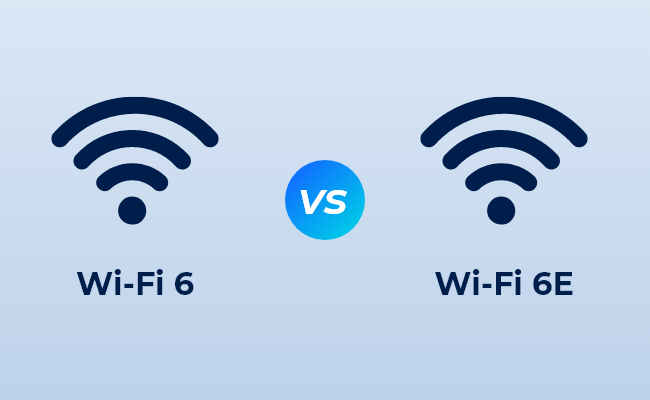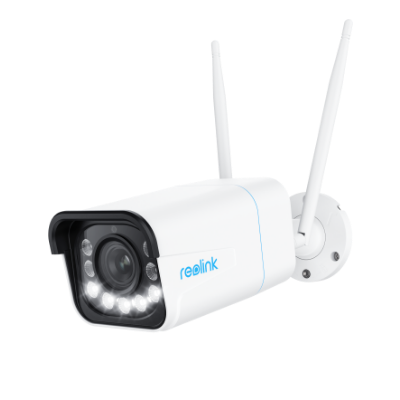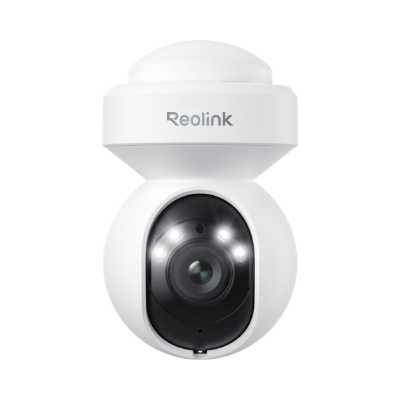Wi-Fi 6 vs 6E: What's the Difference?

If you are thinking about upgrading your Wi-Fi, you might have thought about Wi-Fi 6 and 6E. Choosing one of them is extremely confusing, especially for a non-tech-savvy person.
In this article, we will discuss everything about Wi-Fi 6 and Wi-Fi 6E. We will explain what these are, their differences, supported devices, and which one is better for you.
Basics of Wi-Fi 6 and 6E
What is Wi-Fi 6?
Wi-Fi 6 is the 6th generation and standard technology. In technical terms, it is known as 802.11ax, which is the successor of the Wi-Fi 5 (802.11ac).
It is a way better option than its predecessor in terms of speed, range, number of connected devices, etc. It supports 2.4 GHz and 5 GHz bands, and its speed can reach at 1.146 Gbps up to 15 feet. It is an improved technology ideal for densely populated areas like cities.
It is equipped with MU-MIMO (Multi-User, Multi-Input, Multi-Output) and OFDMA (Orthogonal Frequency Division Multiple Access). The former allows the handling of more devices efficiently, and the latter allows efficient data transmission in crowded places like offices.
What is Wi-Fi 6E?
Wi-Fi 6E, which is the same 802.11ax, is the enhanced version of Wi-Fi 6. Its speed can reach up to 1.788 Gbps at feet, and it transmits data on 2.4 GHz, 5 GHz, and 6 GHz. So, it has an additional frequency band, which translates to more connected devices and minimal signal interference.
It is an excellent option for highly dense and populated areas. However, the issue with Wi-Fi 6E is that it is not backward compatible, so you can't connect all devices, only the ones that support Wi-Fi 6E.
Wi-Fi 6 vs 6E: Key Difference
Although Wi-Fi 6E is the extended version of Wi-Fi 6, there are multiple key differences.
Frequency Bands
The primary differentiator between Wi-Fi 6 and Wi-Fi 6E is the frequency bands.
Wi-Fi 6 transmits data over the 2.4 and 5 GHz. For more data transmission, it can run a single 160 MHz wide channel on the 5 GHz band.
In contrast, Wi-Fi 6E offers three bands: 2.4 GHz, 5 GHz, and 6 GHz. It has an additional band that allows the router to offer seven data channels of 160 MHz. It means it can transmit more data, and multiple devices can benefit from that.
Speeds and Range
The data delivery rate (speed) of Wi-Fi 6 at a distance of 15 feet is 1.146 Gbps, while Wi-Fi 6E can reach up to 1.788 Gbps. Thus, Wi-Fi 6E is approximately 56% faster than Wi-Fi 6.
Wi-Fi 6E can offer an additional 6 GHz band but is limited to a small area. Due to high frequency, it is only available to devices that are very near to the Wi-Fi. And when you go beyond that area, you must connect to the other available bands, 2.4 GHz and 5 GHz. Thus, the range of the 6 GHz band is very limited.
Interference and Congestion
Wi-Fi 6E is better at reducing interference and congestion.
Wi-Fi 6 offers a 5 GHz band, which can only offer one 160 MHz wide channel. It leads to congestion and interference to an extent.
On the other hand, Wi-Fi 6E's 6 GHz band offers seven 160 MHz wide or fourteen 80 MHz wide channels. Due to additional spectrum and wider channels, Wi-Fi 6E reduces interference and congestion.
Moreover, the 6 GHz band is dedicated to Wi-Fi only; it does not face any interference due to other radio signals like Bluetooth and other devices.
Latency
Wi-Fi 6E offers lower latency than Wi-Fi 6. It offers higher speed and more available channels to offer better data transmission to all devices. Moreover, the wider channel widths ensure lower latency by offering higher data rates. It is an ideal option for real-time experience and monitoring.
Here is a comparison list about Wi-Fi 6 and Wi-Fi 6E:
Wi-Fi 6 vs 6E: Which Router and Mesh Wi-Fi You Choose?
Wi-Fi 6 vs 6E Router
If you want to choose between a Wi-Fi 6 and a Wi-Fi 6E router, you have to consider a few important factors.
Wi-Fi 6 offers backward compatibility, which means it can support older devices that support 802.11a, 802.11b, etc. It supports all old Wi-Fi technologies and standards. That means you can connect all your devices without any hassle.
Unfortunately, you can't do this with Wi-Fi 6E. It supports only 802.11ax devices. At this point in time, you won't be able to connect all your devices. There are still other Wi-Fi standards and devices being used.
If you have 802.11ax compatible devices only, you can go with Wi-Fi 6E. By buying a Wi-Fi 6E router, you are investing for the future as it is future-proof, and soon, there will be all 802.11ax compatible and more advanced devices only.
Secondly, if you need better bandwidth, speed, and low latency, you can go with Wi-Fi 6E. For instance, if you do online gaming and use VR, you need Wi-Fi 6E for a smooth experience without starving other devices for bandwidth.
In short, if you need Wi-Fi 6E for bandwidth-intensive applications or special reasons, you can go with that. Otherwise, it is better to stick with Wi-Fi 6.
Mesh Wi-Fi 6 vs 6E
If you build a Wi-Fi 6 mesh, it will reduce the interference and latency and offer higher speed everywhere, even if the place is overcrowded. It will be a future-proof system and a long-term investment. Moreover, it will support bandwidth-intensive applications.
Wi-Fi 6E is undoubtedly beneficial, but it comes with a few shortcomings. Firstly, it won't allow old devices, such as mobile phones and laptops, to connect to the Wi-Fi. So, if you are planning to have Wi-Fi 6E mesh, you will have to upgrade your devices. On the other hand, Wi-Fi 6 can work seamlessly with old Wi-Fi technology and standards.
Bonus: Which Devices Support Wi-Fi 6E?
All devices that are compatible with 802.11ax support Wi-Fi 6E.
Companies have introduced smartphones, tablets, laptops, televisions, IoT devices, gaming consoles, and other devices that support Wi-Fi 6E.
-
Smartphones: Samsung Galaxy S21 Ultra and S22 Ultra, Google Pixel 6 and 6 Pro, Asus ROG Phone 5s, Xiaomi Mi 11 Ultra, iPhone 15 Pro and Pro Max, etc.
-
Laptops: Acer Predator Helios 300, Lenovo ThinkPad X1 Xtreme Generation 4, MacBook Pro (14- and 16-inch Nov 2023), etc.
-
Tablets: Apple iPad Pro 11-inch (4th generation) and iPad Pro 12.9-inch (6th generation)
Routers: TP-Link Archer AXE75, NETGEAR - Nighthawk AXE11000, NETGEAR - Nighthawk AXE7800, etc. -
Smart TVs: Samsung 2021 NEO QLED 8K, Vizio M-series and V-series, etc.
However, the support is only available in new and few devices. So, if you want to use Wi-Fi 6E, you need to upgrade your existing devices to compatible ones.
Is Wi-Fi 6E Worth Upgrading?
It depends on your needs, applications, and existing devices.
If you have old devices compatible with older standards, you won't be able to connect to Wi-Fi 6E. It won't be worth upgrading unless you plan to upgrade your devices as well.
For those who have the latest devices with 802.11ax support, they should go with Wi-Fi 6E. It is worth investing in as it is a future-proof technology. It will also offer better speed, higher bandwidth at multiple channels, less interference, and tons of other benefits.
Upgrading to Wi-Fi 7 would be a more worthy option because it is better than Wi-Fi 6E and also supports backward compatibility.
Wi-Fi 6 Security Camera Recommendation
Smart 4K UHD Wi-Fi 6 Security Camera - RLC-811W
RLC-811WA is a top-notch smart security camera that delivers ultra-clear 4K 8MP Ultra HD video quality. With its advanced features, including 2.4/5 GHz dual-band Wi-Fi for a reliable connection, and 5X optical zoom, it ensures you capture every detail with precision.
4K WiFi 6 Security Camera with Night Vision
4K 8MP Ultra HD, Dual-Band WiFi 6, Color Night Vision, 5X Zoom, Smart Detection, Two-Way Audio, Built-in Siren.
4K Smart PTZ Wi-Fi 6 Camera - E1 Outdoor Pro
E1 Outdoor Pro is an advanced 4K 8MP Smart PTZ Wi-Fi 6 Camera designed for effortless surveillance. With its 2.4/5 GHz Dual-Band Wi-Fi, you can seamlessly connect and monitor your surroundings. The camera features a 3X Optical Zoom, allowing you to get a closer look at specific areas. Its impressive 355° Pan and 50° Tilt capabilities ensure extensive coverage, keeping a vigilant eye on your property.
4K WiFi PTZ Camera with Auto-Tracking
4K 8MP Super HD, Smart Person/Vehicle Alerts, 355° Pan & 50° Tilt & 3X Optical Zoom, Auto Tracking, Color Night Vision.
FAQs
1. Wi-Fi 6 vs 6E vs 7: What's the difference?
Wi-Fi 6 transmits data over 2.4 and 5 GHz bands. However, Wi-Fi 6E and Wi-Fi 7 have an additional band of 6 GHz. The difference between Wi-Fi 6E and Wi-Fi 7 is that the latter can support 320 MHz wide channels, and the former offers up to 160 MHz channel width.
2. Does Wi-Fi 6E go through walls?
Wi-Fi 6E can go through walls, but it can also struggle to some extent. The higher frequency signals, such as 6 GHz, are for a limited range like a room. It can't penetrate through walls. However, the 5 GHz and 2.4 GHz can cover a wider range.
3. Is Wi-Fi 6E better than Wi-Fi 6?
In terms of technology, interference, speed, higher bandwidth channels, and latency, Wi-Fi 6E is better than Wi-Fi 6.
Conclusion
Choosing between Wi-Fi 6 and Wi-Fi 6E could be extremely difficult if you don't know both in-depth. We have explained what they are, the differences between them, and what you should choose. Now, you might have a clear idea, and you can choose the right one according to your applications, the future-proofing you need, existing devices, and other factors.
Search
Be in the Know
Security insights & offers right into your inbox


